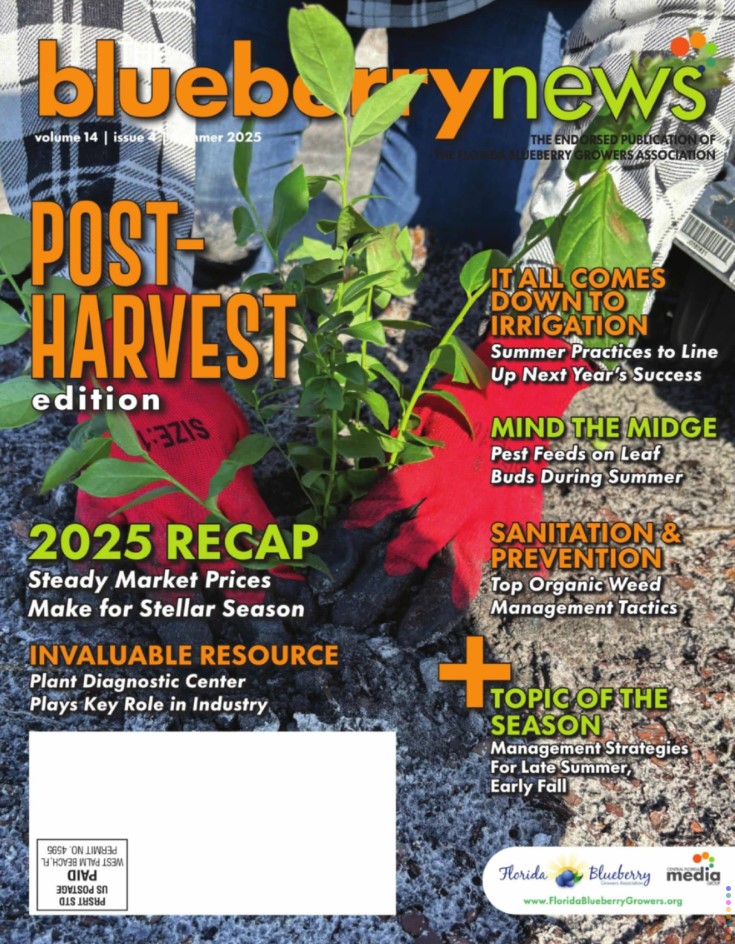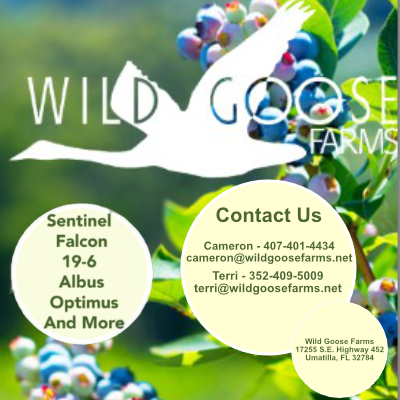Update on Flatheaded Borers Infesting Blueberry Plantings in Central and North-Central Florida
<strong>Beetles vs Blueberries</strong>
Since 2014, several Florida blueberry growers have reported seeing tunneling or girdling around the canes of their bushes (first report in <em>The Blueberry News</em>, winter 2015). In the summer of 2016, the University of Florida Fruit and Vegetable IPM Laboratory received a blueberry bush sample with tunneling present. A flatheaded borer larva (Fig. 1) was found under the bark, feeding on the wood. The larva was cream colored. Body segments 2 and 3 were flattened into a “flat head”, from which the name “flatheaded borer” is derived. The larva was ~1 in long and likely a later stage larva. Earlier stage larvae would be smaller. A preliminary survey of blueberry farms in central and north central Florida in the summer of 2016 found tunnels in bushes on 9 out of 10 farms surveyed. Samples of infested bushes were collected and maintained in a shade house in hopes of rearing out adult beetles for species identification purposes the following spring.
In February 2017, a female beetle belonging to a group of closely related species (the <em>Chrysobothris femorata</em> species group) (Fig. 2) emerged from the infested bushes that were collected during the 2016 survey. However, male beetles are needed to correctly identify species. <em>Chrysobothris femorata</em>, the Flatheaded Appletree Borer (FHATB), is one of the species in the group and is a pest of apples and many other hard wood trees in FL and the southeastern US. Female FHATB lay their eggs in protected crevices on the bark of host trees throughout the summer. Eggs hatch in about 7 days and larvae feed on the outer wood under the bark. Larval feeding creates tunnels filled with frass (larval feces) under the bark of the tree, causing the bark to be “pushed up” along the path of the tunnel. Flatheaded borer larval feeding continues throughout the summer, fall, and winter months. Larvae pupate inside the cane (non-feeding stage) for 1 – 2 weeks and then emerge as adults to begin the cycle again. The specimen collected from blueberries was identified to be in the <em>C. femorata </em>species group and could have a life cycle similar to the FHATB, but the exact details are not yet known.
A more detailed survey was conducted in 2017 in Florida and Georgia. Surveys were conducted at 4 and 5 farms in north-central and central FL, respectively, and 10 farms in GA (19 total farms). Each survey site was a minimum of 2 ha. Sampling was conducted in three 0.4-ha areas on each farm. The sampling locations were chosen based on where previous detections of the borer had been made or were adjacent to wooded areas.
Sampling for larvae was conducted monthly July – October 2017 in FL and August 2017 – January 2018 in GA. Sampling consisted of inspecting the canes and crown of 20 randomly selected blueberry bushes within each sampling area. Borer infestation was marked as ‘new’ (tunnels covered with bark and filled with frass) (Fig. 3) or ‘old’ (tunnels exposed and clear of frass) (Fig. 4). In FL, both old and new tunnels were found in blueberry bushes on all the farms surveyed (9 out of 9). Out of the 1590 bushes inspected, 423 had tunneling (26.6%), of which 165 bushes had new tunnels (39%) and 258 had old tunnels (61%). In both FL regions, new tunnels were observed July through October 2017. In north-central FL, there was a peak in August and October yet tunneling remained low otherwise. In central FL, the incidence of tunneling was higher than in north-central FL and there were two peaks in August and September. In late summer, some infested blueberry canes were showing signs of leaf chlorosis or yellowing of the leaves (Fig. 5); however, this observation was inconsistent among the sampled farms. Research is needed to further understand the seasonal phenology of the pest.
Our survey included both conventional and organic farms, all of which had incidence of tunneling in the bushes. In terms of new tunnel injury, the organic farms had higher incidence than the conventional farms. The difference is likely a result of management tactics. Several conventional growers made either foliar or soil drench applications of a systemic insecticide (imidacloprid or thiamethoxam), which killed the larvae that were feeding on the bushes. Organic growers do not have an insecticide available with systemic properties that can be used to target the pest and therefore must resort to pruning infested canes or removing infested bushes.
Several canes with active tunnels were collected from each survey site in FL by pruning the cane as close to the crown as possible. This was difficult at some sampling sites because the larva had already begun feeding in the crown (Fig. 6). The ends of each cane were sealed with paraffin wax and stored in 18-gal plastic containers for rearing out any woodboring beetles from the canes. Containers were checked periodically for any emerged beetles through May 2018. Several species of beetles have emerged, most of which attack dead decaying wood.
In the GA survey, only one plant out of all 10 farms surveyed was found to have tunneling. The larva is currently being identified.
Trapping for adult beetles was also conducted monthly April – October 2017 in FL and August 2017 – January 2018 in GA using purple panel traps. Traps were made of a 1 ft x 2 ft panel of purple corrugated plastic attached length-wise to a 4 ft tall wooden stake. Panels were coated on both sides with Tanglefoot Insect Barrier (Scotts Company, LLC, Marysville, OH). Traps were deployed at the three locations and sampled for larvae at each site. Several flatheaded borer beetles were collected on the panel traps from three of the surveyed farms in FL. The species included <em>Acmaeodera</em> spp., <em>Buprestis lineata</em>, <em>Chrysobothris chrysoela</em>, and <em>C. femorata</em>. Several male <em>C. femorata </em>were collected, confirming the identity of the pest. In GA, no adult beetles were found throughout the duration of the sampling period.
On some of the farms, disease symptoms were present on infested bushes. Wood boring beetles often attack trees that are already stressed, so it is possible that the blueberry borer is attracted to diseased bushes. Alternatively, the injury caused by the beetle could make bushes more susceptible to disease. Research is underway to determine if there is a correlation.
In terms of control, there is evidence that systemic insecticides, such as imidacloprid and thiamethoxam, will kill developing larvae. Follow all label guidelines for applying insecticides. Pruning and destroying infested canes is a cultural control option and the only option for organic growers currently. Since the beetle appears to attack stressed trees, proper irrigation and nutrient management is also important.
In summary, the flatheaded borer causing the tunneling in Florida blueberries is the flatheaded apple tree borer, <em>Chrysobothris femorata</em>. The borer is present throughout central and north-central Florida. Tunnels are more prevalent in central Florida and on organic farms. The beetles may attack bushes already stressed by disease or other factors. Detection of larval infestation is most likely in mid- to late-summer when “pushed up” tunnels are visible. Control options include minimizing bush stress, pruning of infested canes, and application of systemic insecticides. Monitoring for flatheaded borer injury in Florida blueberries will continue during the 2018 season and summer. There are also plans for studies on its control and how larval feeding affects fruit yield.
Please contact the UF Fruit and Vegetable IPM Lab with questions about or to report incidence of the blueberry borer at <a href="mailto:[email protected]">[email protected]</a> or (352) 273-3926.
by RHODES, E., L. IGLESIAS, J.SPIES, AND O.E. LIBURD
[fusion_builder_container hundred_percent="yes" overflow="visible"][fusion_builder_row][fusion_builder_column type="1_1" background_position="left top" background_color="" border_size="" border_color="" border_style="solid" spacing="yes" background_image="" background_repeat="no-repeat" padding="" margin_top="0px" margin_bottom="0px" class="" id="" animation_type="" animation_speed="0.3" animation_direction="left" hide_on_mobile="no" center_content="no" min_height="none"][caption id="attachment_3389" align="alignnone" width="300"]<img class="wp-image-3389 size-medium" src="http://floridablueberrygrowers.org/wp-content/uploads/2018/07/larvae-300x199.jpg" alt="Flatheaded borer larva " width="300" height="199" /> Fig 1. Flatheaded borer larva found in 2016 sample[/caption]
[/fusion_builder_column][fusion_builder_column type="1_1" background_position="left top" background_color="" border_size="" border_color="" border_style="solid" spacing="yes" background_image="" background_repeat="no-repeat" padding="" margin_top="0px" margin_bottom="0px" class="" id="" animation_type="" animation_speed="0.3" animation_direction="left" hide_on_mobile="no" center_content="no" min_height="none"][caption id="attachment_3391" align="alignnone" width="300"]<img class="wp-image-3391 size-medium" src="http://floridablueberrygrowers.org/wp-content/uploads/2018/07/flathead-300x199.jpg" alt="Chrysobothris femorata " width="300" height="199" /> Fig. 2 Adult female Chrysobothris femorata (species complex) that emerged from bushes sampled in 2016.[/caption]
[/fusion_builder_column][fusion_builder_column type="1_1" background_position="left top" background_color="" border_size="" border_color="" border_style="solid" spacing="yes" background_image="" background_repeat="no-repeat" padding="" margin_top="0px" margin_bottom="0px" class="" id="" animation_type="" animation_speed="0.3" animation_direction="left" hide_on_mobile="no" center_content="no" min_height="none"][caption id="attachment_3392" align="alignnone" width="300"]<img class="wp-image-3392 size-medium" src="http://floridablueberrygrowers.org/wp-content/uploads/2018/07/activetunnel-300x225.jpg" alt="" width="300" height="225" /> Fig. 3. Active tunnel[/caption]
[/fusion_builder_column][fusion_builder_column type="1_1" background_position="left top" background_color="" border_size="" border_color="" border_style="solid" spacing="yes" background_image="" background_repeat="no-repeat" padding="" margin_top="0px" margin_bottom="0px" class="" id="" animation_type="" animation_speed="0.3" animation_direction="left" hide_on_mobile="no" center_content="no" min_height="none"][caption id="attachment_3393" align="alignnone" width="300"]<img class="wp-image-3393 size-medium" src="http://floridablueberrygrowers.org/wp-content/uploads/2018/07/oldtunnel-300x300.png" alt="" width="300" height="300" /> Fig. 4 Old tunnel.[/caption]
[/fusion_builder_column][fusion_builder_column type="1_1" background_position="left top" background_color="" border_size="" border_color="" border_style="solid" spacing="yes" background_image="" background_repeat="no-repeat" padding="" margin_top="0px" margin_bottom="0px" class="" id="" animation_type="" animation_speed="0.3" animation_direction="left" hide_on_mobile="no" center_content="no" min_height="none"][caption id="attachment_3394" align="alignnone" width="225"]<img class="size-medium wp-image-3394" src="http://floridablueberrygrowers.org/wp-content/uploads/2018/07/infestedcane-225x300.jpg" alt="" width="225" height="300" /> Figure 5. Infested cane with yellowing leaves[/caption][/fusion_builder_column][/fusion_builder_row][/fusion_builder_container]





